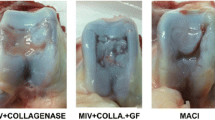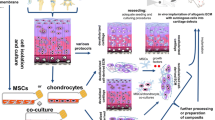Abstract
Cartilaginous tissue has limited capacity for regeneration after damage, since the natural repair process leads to the formation of fibrocartilaginous tissue which does not have the resistance and capability of deformation under load, typical of hyaline cartilage which covers the articular surfaces. The possibility of transplanting human chondrocytes for cartilage reconstruction has been demonstrated in orthopaedics. The scope of our study was to evaluate the possibility of cultivating and expanding human chondrocytes seeded on a pure equine type I collagen support. Human articular cartilaginous cells multiplied and grew on a type I collagen substrate with production of extracellular matrix. This chondrocyte culture showed a correct morphology and phenotype as shown by alcian-PAS staining to indicate the presence of mucopolysaccharides and by immunohistochemical methods to identify type II collagen. The use of scaffolds may lead to improvement in the surgical technique, by making it possible to hold the cells physically in the area to be repaired and by allowing optimum spatial adaptation inside injuries of all shapes.
Similar content being viewed by others
References
Grigolo B, Roseti L, Neri S, Facchini A (2002) Human articular chondrocytes immortalized by HPV-16 E6 and E7 genes: maintenance of differentiated phenotype under defined culture conditions. Osteoarthritis Cartilage 10:879–889
Grigolo B, Roseti L, Fiorini M, Facchini A (2002) Applicazioni dell’ingegneria tissutale: riparazione di lesioni cartilaginee con condrociti autologhi. Reumatismo 54:364–371
Temenoff JS, Mikos AG (2000) Review: tissue engineering for regeneration of articular cartilage. Biomaterials 21:431–440
Kimura T, Yasui N, Ohsawa S, Ono K (1984) Chondrocytes embedded in collagen gels maintain cartilage phenotype during long-term cultures. Clin Orthop Relat Res 186: 231–239
Naumann A, Dennis JE, Aigner J et al (2004) Tissue engineering of autologous cartilage grafts in three-dimensional in vitro macroaggregate culture system. Tissue Eng 10:1695–1706
Shields KJ, Beckman MJ, Bowlin GL, Wayne JS (2004) Mechanical properties and cellular proliferation of electrospun collagen type II. Tissue Eng 10:1510–1517
Woodfield TBF, Malda J, de Wijn J et al (2004) Design of porous scaffolds for cartilage tissue engineering using a three-dimensional fiber-deposition technique. Biomaterials 25:4149–4161
Chaipinyo K, Oakes BW, Van Damme MP (2004) The use of debrided human articular cartilage for autologous chondrocyte implantation: maintenance of chondrocyte differentiation and proliferation in type I collagen gels. J Orthop Res 22:446–455
Zhang Z, McCaffery JM, Spencer RGS, Francomano CA (2005) Growth and integration of neocartilage with native cartilage in vitro. J Orthop Res 23:433–439
De Franceschi L, Grigolo B, Roseti L et al (2005) Transplantation of chondrocytes seeded on collagen-based scaffold in cartilage defects in rabbits. J Biomed Mater Res 75:612–622
Anderer U, Libera J (2002) In vitro engineering of human autogenous cartilage. J Bone Miner Res 17:1420–1429
Martin JMM, Smith M, Al-Rubeai M (2005) Cryopreservation and in vitro expansion of chondroprogenitor cells isolated from the superficial zone of articular cartilage. Biotechnol Prog 21:168–177
Richardson JB, Caterson B, Evans EH et al (1999) Repair of human articular cartilage after implantation of autologous chondrocytes. J Bone Joint Surg Br 81(6):1064–1068
Uchio Y, Ochi M, Matsusaki M et al (2000) Human chondrocyte proliferation and matrix synthesis cultured in Atelocollagen gel. J Biomed Mater Res 50:138–143
Brittberg M, Peterson L, Sjogren-Jansson E et al (2003) Articular cartilage engineering with autologous chondrocyte transplantation. A review of recent developments. J Bone Joint Surg Am 85[Suppl 3]:109–115
Yates KE, Allemann F, Glowacki J (2005) Phenotypic analysis of bovine chondrocytes cultured in 3D collagen sponges: effect of serum substitutes. Cell Tissue Banking 6:45–54
Chaipinyo K, Oakes BW, Van Damme MP (2002) Effects of growth factors on cell proliferation and matrix synthesis of low-density, primary bovine chondrocytes cultured in collagen I gels. J Orthop Res 20:1070–1078
Bassleer C, Gysen P, Foidart JM et al (1986) Human chondrocytes in tridimensional culture. In Vitro Cell Dev Biol 22(3):113–119
Conconi MT, De Coppi P, Di Liddo R et al (2005) Tracheal matrices, obtained by a detergent-enzymatic method, support in vitro the adhesion of chondrocytes and tracheal epithelial cells. Transplant Int 18:727–734
Emans PJ, Surtel DA, Frings EJJ et al (2005) In vivo generation of cartilage from periosteum. Tissue Eng 11:369–377
Dorotka R, Bindreiter U, Macfelda K et al (2005) Marrow stimulation and chondrocyte transplantation using a collagen matrix for cartilage repair. Osteoarthritis Cartilage 13:655–664
Sittinger M, Reitzel D, Dauner M et al (1996) Resorbable polyesters in cartilage engineering: affinity and biocompatibility of polymer fiber structures to chondrocytes. J Biomed Mater Res 33:57–63
Brittberg M, Lindahl A, Nilsson A et al (1994) Treatment of deep cartilage defects in the knee with autologous chondrocyte transplantation. N Engl J Med 331:889–895
Breinan HA, Minas T, Hsu HP et al (1997) Effect of cultured autologous chondrocytes on repair of chondral defects in a canine model. J Bone Joint Surg Am 79:1439–1451
Marcacci M, Berruto M, Brocchetta D et al (2005) Articular cartilage engineering with Hyalograft C. Clin Orthop Relat Res 435:96–105
Hutmacher DW (2000) Scaffolds in tissue engineering bone and cartilage. Biomaterials 21:2529–2543
Henrotin Y, Kurz B, Aigner T (2005) Oxygen and reactive oxygen species in cartilage degradation: friends or foes. Osteoarthritis Cartilage 13:643–654
Mizuno S, Allemann F, Glowacki J (2001) Effects of medium perfusion on matrix production by bovine chondrocytes in three-dimensional collagen sponges. J Biomed Mater Res 56:36–375
Raimondi MT, Falcone L, Colombo M et al (2004) A comparative evaluation of chondrocyte/scaffold constructs for cartilage tissue engineering. J Appl Biomater Biomech 2:55–64
Grande DA, Halberstadt C, Naughton G, Manji R (1997) Evaluation of matrix scaffolds for tissue engineering of articular cartilage grafts. J Biomed Mater Res 34:211–220
Kose GT, Korkusuz F, Ozkul A, Hasirci V (2005) Tissue engineered cartilage on collagen and PHBV matrices. Biomaterials 26:5187–5197
Masi L, Franchi A, Santucci M et al. (1992) Adhesion, growth, and matrix production by osteoblasts on collagen substrata. Calcif Tissue Int 51:202–212
Speer DP, Chvapil M, Volz RG et al (1978) Enhancement of healing in osteochondral defects by collagen sponge implants. Clinical Orthop Rel Res 144:326–335
Hendrickson DA, Nixon AJ, Grande DA, Lust G (1994) Chondrocyte-fibrin matrix transplants for resurfacing extensive articular cartilage defects. J Orthop Res 12:485–497
Johnson TS, Xu JW, Zaporojan V, Yaremchuk MJ (2004) Integrative repair of cartilage with articular and nonarticular chondrocytes. Tissue Eng 10:1308–1315
Sims C, Butler PEM, Cao YL et al (1998) Tissue engineered neocartilage using plasma derived polymer substrates and chondrocytes. Plast Reconstr Surg 101:1580–1585
Lee WK, Ichi T, Ooya T, Yui N (2003) Novel poly(ethylene glycol) scaffolds crosslinked by hydrolysable polyrotaxane for cartilage tissue engineering. J Biomed Mater Res 67A:1087–1092
Frisman DE: www.immunoquery.com. Department of Pathology, Eisenhower Medical Center, Rancho Mirage, California
Sternberg SS (1997) Histology for pathologists. Lippincott Williams Wilkins, Philadelphia
Povysil C, Dundr P, Tvrdik D et al (2004) Desmin-positive and alpha-smooth muscle actin positive chondrocytesin in human defective articular cartilage. Preliminary report. Cesk Patol 41:133–136
Wachsmuth L, Soder S, Fan Z et al (2006) Immunolocalization of matrix proteins in different human cartilage subtypes. Histol Histopathol 21:477–485
Lomas RJ, Jennings LM, Fisher J, Keearney JN (2004) Effects of a paracetic acid disinfection protocol on biocompatibility and biochemical properties of human patellar tendon allografts. Cell Tissue Banking 5:149–160
Author information
Authors and Affiliations
Corresponding author
Rights and permissions
About this article
Cite this article
Negri, S., Farinato, S., Bellomi, A. et al. Tissue engineering: chondrocyte cultures on type I collagen support. Cytohistological and immunohistochemical study. J Orthopaed Traumatol 8, 57–63 (2007). https://doi.org/10.1007/s10195-007-0169-6
Received:
Accepted:
Published:
Issue Date:
DOI: https://doi.org/10.1007/s10195-007-0169-6




